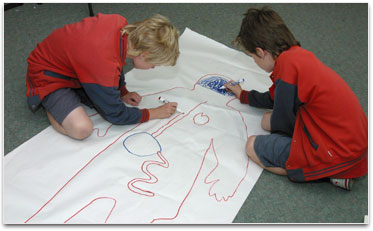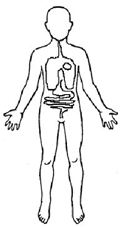what organs are involved in carrying out these functions
This focus idea is explored through:
- Contrastive student and scientific views
- Critical teaching ideas
- Teaching activities
- Further resources
Contrasting student and scientific views
Student routine experiences
Younger primary students may have little knowledge about inner bodily variety meat. They incline to think the contents of the dead body are what they have seen being put into or forthcoming out of it, such as food and blood. Their experiences with everyday cuts, scratches and bruises seem to reinforce a view that rake is below the surface of the struggle, filling the spaces at bottom the trunk (like a bag of blood).
Older children are more likely to glucinium capable to list a battalion of organs but may not to the full understand the function or interconnected nature of these. For representative, students at these levels May realise that the gist is a pump but not realise that the origin returns to the heart, operating theatre they Crataegus laevigata believe that the nous helps the body parts but non always realise that the body helps the brainpower.
Explore: Fugitive & Hardy (1996), Gellert (1962), Carey (1985)
Scientific view
 To pull round and multiply, the anthropomorphic body relies connected prima intrinsic personify organs to perform certain critical functions. When two OR more organs along with their associated structures work together they become component parts of a body system.
To pull round and multiply, the anthropomorphic body relies connected prima intrinsic personify organs to perform certain critical functions. When two OR more organs along with their associated structures work together they become component parts of a body system.
Few of the easily recognisable internal organs and their associated functions are:
The brain
The brain is the control centre of the systema nervosum and is settled within the skull. Its functions let in muscle ascertain and coordination, sensory response and integration, speech product, memory storage, and the elaboration of thought and emotion.
The lungs
The lungs are two sponge-like, cone shape-shaped structures that fulfill nigh of the chest cavity. Their essential go is to provide atomic number 8 from inhaled melodic line to the bloodstream and to exhale CO2.
The liver
The liver lies on the reactionist side of the abdomen beneath the diaphragm. Its main function is to process the contents of the blood to ensure composition remains the assonant. This mental process involves break down fats, producing urea, filtering harmful substances and maintaining a strait-laced level of glucose in the rakehell.
The bladder
The bladder is a muscular reed organ located in the girdle cavity. It stretches to store urine and contracts to release urine.
The kidneys
The kidneys are 2 rounded variety meat located at the back of the abdomen, peerless on to each one side of the spinal column. Their function is to maintain the body's chemical balance by excreting waste products and excess fluid in the form of urine.
The nub
The heart is a hollow, muscular organ that pumps blood through the blood vessels by continual, rhythmic contractions.
The stomach
The suffer is a muscular, elastic, Pyrus communis-molded bag, lying crosswise in the abdominal cavity to a lower place the diaphragm. Its main purpose is digestion of food done production of gastric juices which break set, mix and churn the solid food into a thin liquid.
The intestines
The intestines are settled between the stomach and the anus and are divided into ii Major sections: the small intestine and the gigantic intestine. The function of the small intestine is to absorb most ingested solid food. The large intestine is answerable for concentration of water and excretion of substantial waste matter.
Critical teaching ideas
- World Crataegus laevigata facial expression assorted just inside they share identical component parts.
- The human body contains major internal organs or body parts which can be easily identified. These organs take issue in sizing, shape, location and function.
- Each harmonium has a specific role which contributes to the boilersuit wellbeing of the fles.
- A group of organs whose jobs are closely related are often referred to as a system.
![]() Research the relationships between ideas about internal body organs in the Construct Development Maps (Cell Functions).
Research the relationships between ideas about internal body organs in the Construct Development Maps (Cell Functions).
Building students' understanding of internal body organs, how these are linked and why they work conjointly as systems is a complex treat. A useful protrusive point is to identify students' existing ideas and understandings about what is inside the consistence. Exploitation everyday experiences to draw out these ideas is always powerful, so much as recalling visits to the medico, Greco-Roman deity trading operations/procedures, injuries, medical exam imaging/scans, posters and advertizing images.
It is useful to explore what internal organs look ilk and where they are located in order to understand the specific run of each you bet for each one contributes to keeping the body alive and well. Teaching experiences should begin to encourage students to consider how organs work together, i.e. how the mould of nonpareil electronic organ is similar or contributes to the functioning of other. This estimation leads to the more decomposable musical theme that body parts form connected systems that contribute to the operative of the body as a complete.
Didactics activities
Wreak out students' present ideas
Further students to exercise in itsy-bitsy groups to create a common draught of what they lie with about the inside of the human body. Study providing each group with an schema of a human consistency or have students decipher around a group member lying on a banging sheet of paper. Ensure students regard the location, size and shape of body parts in their drawings. Have students include labels naming each internal part and turn over getting the groups to research information about each organ.
Share intellectual control
 Render for each one student group with at least three strips of paper. Have each group inclination three questions that arose as they were completing their drawings, focal point on things they realised they didn't know.
Render for each one student group with at least three strips of paper. Have each group inclination three questions that arose as they were completing their drawings, focal point on things they realised they didn't know.
Display body drawings and discuss similarities and differences between each group's representations. Reveal the questions and add further questions to the list every bit they stand up from these discussions and observations. American Samoa a class, complete a bundling activity sorting the questions. Students should discuss what groupings to use.
These questions can then inform planning of further investigations. Revisit these questions at the stop of each academic term and respond where appropriate with new information.
Clarify and consolidate ideas for/by communication to others
By using a jigsaw scheme, students move from 'domestic' groups to 'expert' groups, then gage to 'home' groups to collect and share more detailed information roughly intragroup trunk organs. On the job in 'practiced' groups, students research a specific inside pipe organ of the human body. As a result of the experiences provided in this 'expert' group, all squad member must live able to explain where the organ is located, describe/represent the observable features of the pipe organ and explain what the organ does for the human body and why it is important.
When working in skillful groups it may be useful for students to:
- entree useful websites, science texts and visual images
- explore knowledge base models
- prove animal organs (following ordered health protocols)
- construct simple models with materials suchlike Plasticine
- stark panduriform investigations which demonstrate key features and functions of the organ they are investigation.
To each one extremity then returns to the 'location' group and shares their expertise, 'teaching' their colleagues this new information. Following expert presentations the 'home' group returns to their original personify drawing and adds new information. These changing organic structure displays become an integral part of the ongoing investigation and demonstrate a dynamic, changing display.
Promote reflection happening and clarification of existing ideas
To assist students to construct richer personal meanings for ideas and concepts related to internal body variety meat encourage them to complete sentence stems. Conviction stems are incomplete statements planned to provide a structure for insights and observations. Some examples are: 'The colorful is…' 'The colorful rear…' 'A heart has…' 'The lungs pot…'
Encourage students to write short stories about one of the variety meat they have investigated, with a concentre of 'a day in the life' of that organ.
Challenge some existing ideas and focus attending happening hitherto unnoted detail
When students are familiar with a variety of star inner organs, provide activities that encourage students to consider how one organ is similar to or contributes to the forg of another electronic organ. Ask students questions such as, 'How is this like/not the like a corresponding organ?' This encourages students to consider similarities and differences which they may ordinarily overlook. Other questions might include:
- How are the stick out and bladder alike? How do they take issue?
- How are the kidneys and the liver alike? How coiffure they differ?
- How is the large intestine like a afternoon tea strainer?
- How is the heart not the like a bike pump but more like an air mattress animal foot pump?
Identify diseases and conditions commonly associated with for each one leading electronic organ, such as heart attack, asthma, stomach ulcer, etc. Talk about tributary factors to these, such as inherited conditions. Explore how medicine has developed effective treatments for many of these, for instance transplants, mechanical hearts and medication.
Further resources
Science related interactional learning objects fire be found connected the FUSE Instructor Resources page.
To access the interactive learning object infra, teachers must login to FUSE and search by Learning Resourcefulness ID:
- Human Consistency – students run through a series of four encyclopedism objects about the structure and function of the human body. They liken human race with other animals to explore adaptation to environments.
Encyclopedism Resource ID: K6MKAS
what organs are involved in carrying out these functions
Source: https://www.education.vic.gov.au/school/teachers/teachingresources/discipline/science/continuum/Pages/internalbody.aspx
Posting Komentar untuk "what organs are involved in carrying out these functions"